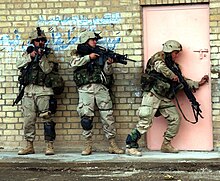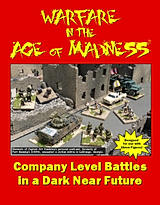- Each Game Turn is divided into a Red Player Turn followed by a Blue Player Turn
- During his Player Turn the player activates each unit, one at a time
- When activated a unit has 2 Action Points and may be given a 3rd AP under certain circumstances
- Each action (eg Move or Shoot) costs 1 or 2 AP
MULTIPLE PLAYERS
We enjoy multi-player gaming, usually with four to eight players. When we tried the traditional IGOYOU sequence with fixed move-shoot-melee-morale phases we ran into two problems. Too often you end up with a lot of players sitting around for extended periods when they don't need to shoot or assault and just two players are engaged in a hot and heavy firefight. And it can be like herding cats trying to keep the entire table coordinated to the same phase. Usually one part of the table is racing ahead to a later phase while another part is bogged down in an earlier phase. Confusion and hilarity ensues.
NEW/CASUAL PLAYERS
Many of us have kids who enjoy gaming, spouses or friends who game casually, and veteran gamer-friends to whom we want to teach a game. Trying to learn, remember and execute a fixed sequence of many phases and sub-phases can be confusing and tedious to them. Kids and casual gamers see their unit and want to DO something with the unit. And they naturally want to finish doing that thing with the first unit before moving on to the next one. Based on our observations players seem to naturally "sequence" from unit to unit. Furthermore, it's easier and more natural for players new to a game system, even hardcore veterans, to move from unit to unit rather than having to learn a specific sequence of phases which may seem arbitrary to them.
TAKING TURNS IS NATURAL
After much trial and even more error we evolved our 3-point action system, the core of our game. We still use a natural, intuitive IGOUGO approach at a high level since every gamer has used such as system from childhood. People naturally "take turns" whether playing a game in pre-school, playing cards in college or navigating a four-way intersection while driving to work (well, they should anyway to avoid accidents!). Thus in Warfare in the Age of Madness each Game Turn is divided into two Player Turns. During each Game Turn the Red Player goes followed by the Blue Player. It's simple, natural, and easy to learn since everyone from pre-schoolers to the elderly are used to taking turns!
ONE THING AT A TIME
As explained above, we decided to eschew the traditional fixed-phase approach for a unit activation approach. During "my turn" I activate or pass each of my units which serve as a mnemonic for my entire turn. Instead of having to learn, remember, and coordinate multiple phases and sub-phases I have X number of units to activate (or pass) and when I've done that with all of my units my turn is over. It's natural, intuitive, and there's very little to remember since the troops serve as a memory aid. This is especially valuable to younger players and players new to the game since all he or she needs to think about is, "Did I do something with all of my guys?"
HOW SHOULD YOU SPEND YOUR TIME?
As the player turns his attention to each of his units he or she has a very simple but challenging decision to make: how should a given unit spend its time this turn? The "economy" of the game is "action points" which provide a simple, easy to learn and remember way to decide how to spend a unit's time during a game turn.
Every unit has its own 2 Action Points (AP) and each action costs 1 or 2 action points. A unit can acquire a third AP from the force's pool of Motivation Points (1 MP can be used as an AP) or by being in "command range" of the force's leader. No unit can use more than 3 AP during its player turn.
A player gets to spend a unit's Action Points in any combination or order. A Move action costs 1 AP. A Shoot Action costs 2 AP. An Assault action costs 2 AP. Other actions such as recovering from the effects of combat, securing Victory Points, and supporting other elements are also available.
So a unit could use two AP to move twice or shoot once. If given a third AP a unit could move and then shoot or shoot and then move. The only thing to remember is that your unit has 2 or 3 AP and each action costs 1 or 2 AP.
During multi-player gaming there's also virtually no need to coordinate actions by players unless they really want to. Technically each unit activates one at a time and you can't "take back" an activation. But this approach frees players up and down the table to keep going until they've "done something" or passed with each of their units.
PAY ATTENTION!
The game's Alert action also provides opportunities for tough decision making and player interaction during opposing player turns. The Alert action costs 2 AP and allows a unit to perform an action during the ENEMY'S player turn in reaction to an enemy's action.
So if a unit spends 2 AP to go on Alert during its own Player Turn it's betting that it will have an opportunity to react during the opposing turn. This opens up all sorts of interesting dilemmas!
Do I shoot now or go on Alert to take an opportunity shot in the enemy turn? I might be missing a chance to shoot an enemy. Do I move two or three times to gain ground? I could be hanging the unit out to dry as an enemy simply moves once and then shoots. But maybe the move prevents the enemy from trying to secure an objective...
The result is that both players are constantly engaged during each player's turn. You must carefully observe how an opponent is spending APs and positioning troops as you prepare for your turn. And of course you must decide if and when to react with your own Alert elements. Sometimes an enemy move is merely an attempt to draw fire...other times it's an opportunity to score a kill against a rash opponent. You must pay attention constantly.
QUALITY AND LEADERSHIP MATTER
The system also elegantly represents the value of good troops and leadership. Anyone who has supervised others in an organization know that some people are self-motivated and others need a kick in the pants just to do the basics.
In Warfare in the Age of Madness each force has from 1 to 5 Motivation Points based on its quality. A Motivation Point (MP) can be expended to re-roll a die or to feed any unit a third Action Point. At the start of a player's turn his MP pool is refilled. This represents units beyond a leader's direct supervision using their own initiative to do more than that allowed by 2 Action Points.
Units within a certain distance of a Command Element on Alert status start their activation with 3 AP instead of the standard 2 AP. That distance represents the force's level of coordination, communication, and control quality.And some units start their activation with 3 AP without the need to be supervised or to use MP. These includes troops such as Recon forces used to operating independently.
CONCLUSION
Each turn sequence system has its own advantages and disadvantages. The system used in Warfare in the Age of Madness would not work for every type of gaming or gaming group. But if you want an easy to learn and easy to remember system that represents different force types and levels of quality and allows for player reactions then you just might be mad enough to try Warfare in the Age of Madness!



%2C_Special_Boat_Team_22_conducts_training_16_AUG_09.jpg/220px-U.S._Navy_special_warfare_combatant-craft_crewmen_(SWCC)%2C_Special_Boat_Team_22_conducts_training_16_AUG_09.jpg)




